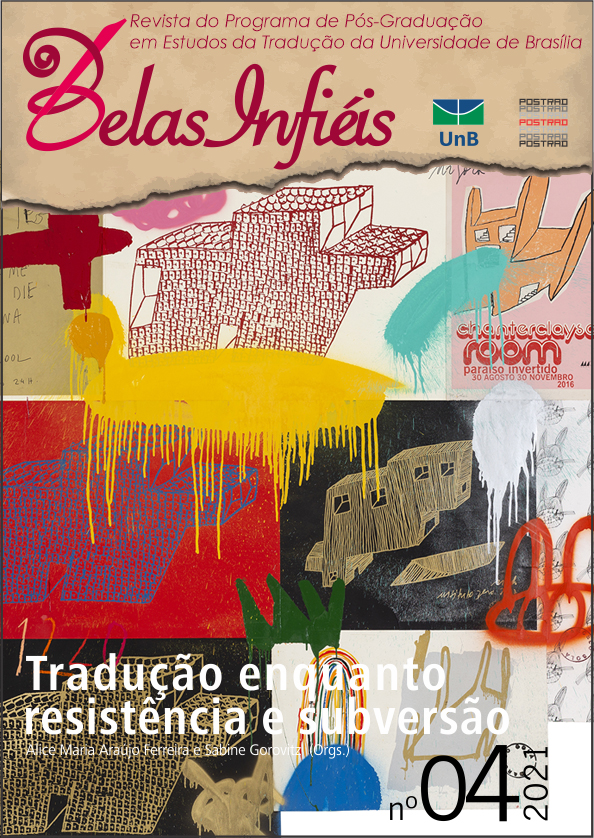La Théorie Interprétative à L’heure de la Traduction Communautaire en Afrique
DOI :
https://doi.org/10.26512/belasinfieis.v10.n4.2021.36795Mots-clés :
Théorie Interprétative. Traduction Communautaire. Didactique de la Traduction. Langues Africaines. Littéracie.Résumé
Dans les principes qui en constituent le fondement, la théorie interprétative de la traduction prône une réflexion sur le processus de traduction principalement axée sur les mécanismes de quête et de transfert du sens exprimé dans l’original. Cette approche théorique de l’opération traduisante a surtout le mérite de ne pas être restreinte à une catégorie de langues donnée, tant les méthodes qu’elle propose invitent à une nette démarcation des contingences formelles que constitue la langue du texte-source. Cette étude ouvre une réflexion sur la pertinence de la théorie interprétative, dont elle interroge le caractère universel, dans une perspective de didactique de la traduction en langues africaines aux fins d’améliorer l’accès à une citoyenneté active des communautés locales.
Téléchargements
Références
Catford, J. C. (1965). A Linguistic Theory of Translation. Oxford University Press.
Delisle, J. (1980). L’analyse du discours comme méthode de traduction. Éditions de l’Université d’Ottawa.
Diki-Kidiri, M. (2004). Multilinguisme et politiques linguistiques en Afrique. Colloque développement durable : leçons et perspectives, juin, 1–4
Durieux, C. (2009). Vers une approche décisionnelle de la traduction. La Revue LISA / LISA e-journal, VII(3), 349–367.
Gerbault, J. (2013). Gestion de la traduction : regards sur l'Afrique sub-saharienne du XXIe siècle. Le Bulletin du CRATIL, (10), pp. 56–71.
Halaoui, N. (1991). La terminologie des langues africaines, esquisse d’une problématique. Meta, 36(1), 291–300.
Halaoui, N. (1987). Le bilinguisme dans la rédaction du lexique spécialisé. Bofcan, (8), pp. 189–202.
Ilboudo, P. C. (1986). Le mariage de Tinga. Editions Silex.
Israel, F., & Lederer, M. (2005). La théorie interprétative de la traduction I. Genèse et développement. Minard.
Johnson-Laird, P. N. (1983). Mental Models: Toward a Cognitive Science of Language, Inference and Consciousness. Harvard University Press.
Klimkiewicz, A. (2005). L’interprétation communautaire : un modèle de communication « trialogique ». TTR, 18(2), 209–224.
Ladmiral, J.-R. (2005). Cousinages intellectuels. In F. Israël & M. Lederer (Eds.), La Théorie interprétative de la traduction (Tome 1, pp. 141–162). Minard.
Larose, R. (1989). Théories contemporaines de la traduction (2e éd). Presses de l’Université du Québec.
Lederer, M. (1994). La traduction aujourd'hui. Le modèle interprétatif. Hachette.
Lederer, M. (1997). La théorie interprétative de la traduction : un résumé. Revue des lettres et de traduction, (3), 11–20.
Lederer, M. (2015). Interpréter pour traduire, de Danica Seleskovitch et Marianne Lederer, nouvelle édition dans la collection Traductologiques, chez les Belles Lettres. Le Bulletin du CRATIL, (14), pp. 139–144.
Martin, A. (2000). La interpretación social en España. In D. Kelly (Ed.), La traducción y la interpretación en España hoy. Perspectivas profesionales (pp. 207–223). Comares.
Mounin, G. (1963). Les problèmes théoriques de la traduction. Gallimard.
Pöchhacker, F. (2001). Quality Assessment in Conference and Community Interpreting. Meta, XLVI(2), 409–425.
Rakova, Z. (2014). Les théories de la traduction. Masarykova univerzita.
Sambou, A. (2012). Traduction pédagogique et didactique des LVE en contexte multilingue: le cas du Sénégal. Implications sociolinguistiques [Thèse à la carte, ANRT].
Seleskovitch, D., & Lederer, M. (1984). Interpréter pour traduire. Minard.
Valero Garcés, C., & Dergam, A. (2003). ¿Mediator social = Mediator interlingüistico = Interprete? Prática, formación y reconocimiento social del interprete en los servicios públicos. In Á. C. Aís & J. M. Martín Pasadas, La evaluación de la calidad en interpretación: docencia y profesión. Comares.
Téléchargements
Publié-e
Comment citer
Numéro
Rubrique
Licence
(c) Tous droits réservés CC BY 2021

Cette œuvre est sous licence Creative Commons Attribution 4.0 International.
Copyright Statement
Given the public access to this journal, the texts are free to use but requires the recognition of the original authorship and initial publication in this journal to be properly stated.
The journal allows the use of works published for non-commercial purposes, including the right to submit the work to publicly accessible databases. Published contributions are the sole and exclusive responsibility of the author(s).
- When submitting papers to be evaluated by the Belas Infiéis journal, the author(s):
- Declare that the contents of the contributions are original and of their original creation, being entirely responsible for their content if there is an objection by third parties.
- Claim to be aware that they should not commit academic plagiarism.
- Declare that the manuscript has not been published, completely or partially, in Portuguese or another language. If it is a translation it should be submitted to the Translated Articles section.
- Declare that the manuscript is not being evaluated by other journals.
- Declare that the manuscript was not submitted to another journal simultaneously.
- Commit(s) to inform the journal of any kind of error or inaccuracy in their contribution (published, in evaluation or in editing) and to collaborate with the editors to make due corrections of the article (when in evaluation or editing) or erratum/retraction (after publication).
- Declare that there is no conflict of interest regarding the published work.
- Authorize its release if it is accepted for publication without any kind of monetary compensation.
- Agree to assign non-exclusive rights to publication to the magazine, remaining free to make their contribution available in other media as long as the publication of the first version in Belas Infiéis magazine is mentioned. They also authorize Belas Infiéis to assign their texts for reproduction in content indexers, virtual libraries and similar platforms.
- Maintain copyright and grant the journal the right of first publication, the work being licensed under theCreative Commons Attribution License.
- Is/Are allowed and encouraged to publish and distribute their work online after the editorial process, which may increase the impact and citation of the published work.
- Authorize the editorial team to make textual adjustments and to adapt the article to the publication rules, when necessary.



















